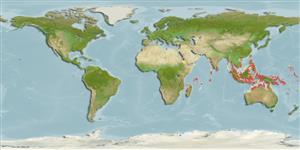Common names from other countries
>
Siluriformes (Catfishes) >
Ariidae (Sea catfishes) > Ariinae
Etymology: Arius: Greek, arios, areios = dealing with Mars, warlike, bellicose (Ref. 45335).
More on author: Valenciennes.
Environment: milieu / climate zone / depth range / distribution range
Ecologia
marinhas; estuarina demersal; não migratória; intervalo de profundidade 0 - 20 m (Ref. 43081). Tropical
Indo-West Pacific: Pakistan east to Thailand then south to the Philippines and Indonesia.
Tamanho / Peso / Idade
Maturity: Lm ? range ? - ? cm
Max length : 39.5 cm NG macho/indeterminado; (Ref. 43081); common length : 12.0 cm TL macho/indeterminado; (Ref. 3290)
Found in marine waters, as well as estuaries and tidal rivers, at times burrowed in the soft mud of the mangroves. Feed mainly on invertebrates. Males incubate the eggs in the buccal cavity (Ref. 43081). The sharp dorsal and pectoral fin spines can inflict painful wounds. Also caught with dipnets and set bagnets. Sold mostly fresh.
Males incubate the eggs in the buccal cavity.
Jayaram, K.C., 1984. Ariidae. In W. Fischer and G. Bianchi (eds.) FAO species identification sheets for fishery purposes. Western Indian Ocean fishing area 51. Vol. 1. FAO, Rome. pag. var. (Ref. 3290)
Status na Lista Vermelha da UICN (Ref. 130435)
CITES (Ref. 128078)
Not Evaluated
Ameaça para os humanos
Traumatogenic (Ref. 3290)
Uso pelos humanos
Pescarias: espécies comerciais
Ferramentas
Relatórios especiais
Baixar XML
Fontes da internet
Estimates based on models
Preferred temperature (Ref.
115969): 27.4 - 29.3, mean 28.7 (based on 1689 cells).
Índice de diversidade filogenética (Ref.
82804): PD
50 = 0.5000 [Uniqueness, from 0.5 = low to 2.0 = high].
Bayesian length-weight: a=0.00776 (0.00492 - 0.01225), b=2.98 (2.85 - 3.11), in cm Total Length, based on LWR estimates for this species & (Sub)family-body (Ref.
93245).
Nível Trófico (Ref.
69278): 2.8 ±0.31 se; based on food items.
Resiliência (Ref.
120179): Baixo, tempo mínimo de duplicação da população 4,5 - 14 anos (Fec=25-35).
Fishing Vulnerability (Ref.
59153): Low to moderate vulnerability (34 of 100).
